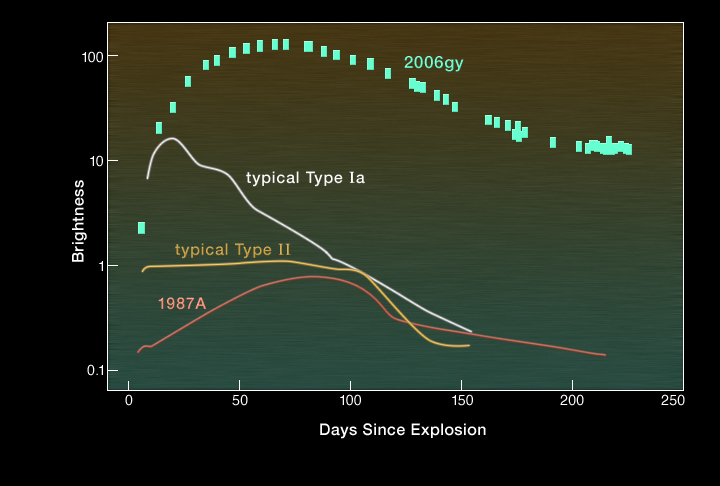|
|||||||
|
|
|
 |
|
|
Strumenti |
|
|
#1 |
|
Bannato
Iscritto dal: Aug 2001
Città: Berghem Haven
Messaggi: 13513
|
Chandra vede la supernova più luminosa mai osservata
Paura
 http://www.universetoday.com/2007/05...est-supernova/ NASA’s Chandra X-Ray observatory might have observed a brand new kind of supernova, or maybe it’s just an unusually bright supernova. Whatever the case, the explosion of SN 2006gy seems to be the brightest supernova ever observed, flaring with 100 times the energy of a typical exploded star. The team that discovered SN 2006gy think that the original star might have contained 150 times the mass of our Sun; only the first generation of stars that formed after the Big Bang were thought to be this massive. It was the Chandra X-Ray observations that helped distinguish the supernova as originating from a massive star, and not the Type 1A associated with an exploding white dwarf star. A supernova occurs when a massive star consumes its fuel, loses outward pressure, and collapses inward under its own gravity. But in the case of SN 2006gy, there might be an entirely new process going on here. The precursor star could have been so large that its core produces a large amount of gamma rays. The energy from this radiation is converted into particle and anti-particle pairs, and causes a drop in energy. Without this energy, the star collapses from its own gravity early and detonates as a supernova. Even though SN 2006gy is the intrinsically brightest supernova ever seen, it exploded in galaxy NGC 1260, which is located about 240 million light-years away - so you need a powerful telescope to see it. The closest star that’s in the same category is Eta Carinae, a massive star located only 7500 light-years away. No telescope will be necessary when it explodes.  http://chandra.harvard.edu/press/07_...ss_050707.html WASHINGTON - The brightest stellar explosion ever recorded may be a long-sought new type of supernova, according to observations by NASA's Chandra X-ray Observatory and ground-based optical telescopes. This discovery indicates that violent explosions of extremely massive stars were relatively common in the early universe, and that a similar explosion may be ready to go off in our own galaxy. "This was a truly monstrous explosion, a hundred times more energetic than a typical supernova," said Nathan Smith of the University of California at Berkeley, who led a team of astronomers from California and the University of Texas in Austin. "That means the star that exploded might have been as massive as a star can get, about 150 times that of our sun. We've never seen that before." Astronomers think many of the first generation of stars were this massive, and this new supernova may thus provide a rare glimpse of how the first stars died. It is unprecedented, however, to find such a massive star and witness its death. The discovery of the supernova, known as SN 2006gy, provides evidence that the death of such massive stars is fundamentally different from theoretical predictions. "Of all exploding stars ever observed, this was the king," said Alex Filippenko, leader of the ground-based observations at the Lick Observatory at Mt. Hamilton, Calif., and the Keck Observatory in Mauna Kea, Hawaii. "We were astonished to see how bright it got, and how long it lasted." The Chandra observation allowed the team to rule out the most likely alternative explanation for the supernova: that a white dwarf star with a mass only slightly higher than the sun exploded into a dense, hydrogen-rich environment. In that event, SN 2006gy should have been 1,000 times brighter in X-rays than what Chandra detected. "This provides strong evidence that SN 2006gy was, in fact, the death of an extremely massive star," said Dave Pooley of the University of California at Berkeley, who led the Chandra observations. The star that produced SN 2006gy apparently expelled a large amount of mass prior to exploding. This large mass loss is similar to that seen from Eta Carinae, a massive star in our galaxy, raising suspicion that Eta Carinae may be poised to explode as a supernova. Although SN 2006gy is intrinsically the brightest supernova ever, it is in the galaxy NGC 1260, some 240 million light years away. However, Eta Carinae is only about 7,500 light years away in our own Milky Way galaxy. "We don't know for sure if Eta Carinae will explode soon, but we had better keep a close eye on it just in case," said Mario Livio of the Space Telescope Science Institute in Baltimore, who was not involved in the research. "Eta Carinae's explosion could be the best star-show in the history of modern civilization." Supernovas usually occur when massive stars exhaust their fuel and collapse under their own gravity. In the case of SN 2006gy, astronomers think that a very different effect may have triggered the explosion. Under some conditions, the core of a massive star produces so much gamma ray radiation that some of the energy from the radiation converts into particle and anti-particle pairs. The resulting drop in energy causes the star to collapse under its own huge gravity. After this violent collapse, runaway thermonuclear reactions ensue and the star explodes, spewing the remains into space. The SN 2006gy data suggest that spectacular supernovas from the first stars - rather than completely collapsing to a black hole as theorized - may be more common than previously believed. "In terms of the effect on the early universe, there's a huge difference between these two possibilities," said Smith. "One pollutes the galaxy with large quantities of newly made elements and the other locks them up forever in a black hole." The results from Smith and his colleagues will appear in The Astrophysical Journal. NASA's Marshall Space Flight Center, Huntsville, Ala., manages the Chandra program for the agency's Science Mission Directorate. The Smithsonian Astrophysical Observatory controls science and flight operations from the Chandra X-ray Center in Cambridge, Mass. Ultima modifica di lowenz : 08-05-2007 alle 08:41. |
|
|

|
|
|
#2 |
|
Bannato
Iscritto dal: May 2001
Città: Versilia
Messaggi: 1503
|
potrebbe essere una coalescenza di 2 stelle di 70 80 ms
|
|
|

|
|
|
#3 |
|
Senior Member
Iscritto dal: Dec 2005
Città: Calabria - Emilia Romagna
Messaggi: 2554
|
ragazzi...mi sapete dire in quale constellazione si trova???
|
|
|

|
|
|
#4 |
|
Bannato
Iscritto dal: Aug 2001
Città: Berghem Haven
Messaggi: 13513
|
|
|
|

|
|
|
#5 | |
|
Bannato
Iscritto dal: Aug 2001
Città: Berghem Haven
Messaggi: 13513
|
Quote:
Perseo |
|
|
|

|
|
|
#6 | |
|
Senior Member
Iscritto dal: Dec 2005
Città: Calabria - Emilia Romagna
Messaggi: 2554
|
Quote:
edit...e porca vacca...perseo non si vede in sto periodo Ultima modifica di Dj Ruck : 08-05-2007 alle 10:02. |
|
|
|

|
|
|
#7 |
|
Bannato
Iscritto dal: May 2001
Città: Versilia
Messaggi: 1503
|
|
|
|

|
|
|
#8 |
|
Bannato
Iscritto dal: Aug 2001
Città: Berghem Haven
Messaggi: 13513
|
|
|
|

|
|
|
#9 |
|
Bannato
Iscritto dal: May 2001
Città: Versilia
Messaggi: 1503
|
cosi ad occhio
150 ms sono tante nell universo attuale dove si osservano stelle da 50 70 ms mi pare che il limite teorico per una stella che si formasse ora è 100 ms o qualcosa del genere... |
|
|

|
|
|
#10 |
|
Bannato
Iscritto dal: May 2003
Città: San Gimignano (Siena) - /!\ bannato con onore per cambio nick: ora sono erythraeum /!\
Messaggi: 919
|
|
|
|

|
|
|
#11 | |
|
Bannato
Iscritto dal: May 2001
Città: Versilia
Messaggi: 1503
|
Quote:
|
|
|
|

|

|
| Strumenti | |
|
|
Tutti gli orari sono GMT +1. Ora sono le: 16:16.























